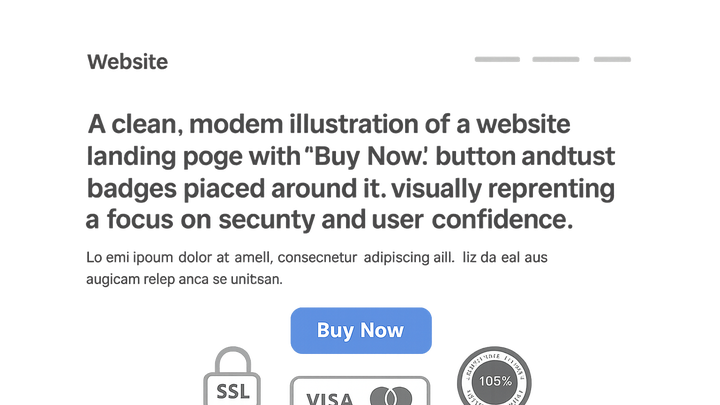Published on 2025-06-29T20:20:43Z
What Are Trust Badges? Examples and Best Practices
Trust badges are small visual icons or seals placed on websites to signal credibility, security, and trustworthiness to visitors. Commonly seen in e-commerce and service sites, these badges indicate secured transactions (e.g., SSL/TLS certificates), accepted payment methods (e.g., Visa, Mastercard), money-back guarantees, and third-party endorsements (e.g., Trustpilot, BBB). By providing immediate visual reassurance, trust badges reduce perceived risk, enhance user confidence, and boost conversion rates. From a UX perspective, they simplify decision-making and improve overall site usability. In terms of SEO, well-positioned trust badges can lower bounce rates and increase dwell time, indirectly supporting better search engine rankings. Platforms like Prevue.me audit trust badge placement, design consistency, accessibility, and performance impact to deliver actionable critiques for maximum lead generation.
Trust badges
Trust badges are visual signals on websites that build credibility and increase conversions by assuring security and reliability.
Understanding Trust Badges
Trust badges are visual seals or icons that communicate a website’s reliability and security to users. This section covers their purpose and common examples seen across e-commerce and service sites.
-
Definition and purpose
Trust badges are icons or seals that signal to users that a website is secure, reliable, and credible, helping to reduce perceived risk.
-
Common examples
Examples of trust badges include security seals, payment logos, money-back guarantees, and third-party accreditation symbols.
- Security seals:
Icons like SSL/TLS certificates and site security badges (e.g., Norton Secured) that indicate encrypted connections.
- Payment logos:
Accepted method icons such as Visa, Mastercard, PayPal, and other payment processor badges.
- Guarantee seals:
Money-back or satisfaction guarantee badges that assure customers of risk-free purchases.
- Review ratings:
Third-party endorsements like Trustpilot, BBB, or Google Reviews that showcase customer feedback.
- Security seals:
Benefits for CRO, UX, and SEO
Trust badges play a critical role in conversion rate optimization, user experience improvement, and SEO performance gains.
-
Boosting conversion rates
By providing reassurance, trust badges help reduce cart abandonment and encourage users to complete desired actions.
- Increased user confidence:
Users feel more secure sharing personal information and making purchases.
- Higher click-through rates:
Calls-to-action adjacent to trust badges often see improved engagement.
- Increased user confidence:
-
Enhancing user experience
Trust badges simplify decision-making and reduce friction by clearly indicating site security and reliability.
- Visual reassurance:
Quickly communicates trustworthiness through familiar icons.
- Reduced cognitive load:
Minimizes user doubts and streamlines the purchase process.
- Visual reassurance:
-
Supporting seo performance
Better engagement metrics influenced by trust badges can positively impact search rankings.
- Lower bounce rates:
Engaged visitors stay longer when they feel assured of site credibility.
- Potential rich snippets:
Structured trust badges can appear in search results, improving visibility.
- Lower bounce rates:
Best Practices for Implementation
Maximize trust badge effectiveness with strategic placement, consistent design, and accessibility considerations.
-
Strategic placement
Position trust badges where they are most visible to reinforce confidence during key user interactions.
- Above-the-fold visibility:
Place critical badges near the top of the page to ensure immediate awareness.
- Proximity to ctas:
Position badges adjacent to ‘Add to Cart’ or ‘Buy Now’ buttons.
- Above-the-fold visibility:
-
Design consistency
Ensure badges align with your site’s visual style for a cohesive user experience.
- Matching aesthetic:
Use colors and shapes that complement your brand identity.
- High-resolution icons:
Implement clear, scalable graphics for sharp display on all devices.
- Matching aesthetic:
-
Accessibility and performance
Optimize badges for all users and minimize any negative impact on page speed.
- Alt text and aria labels:
Provide descriptive alternative text for screen readers.
- Optimized file sizes:
Compress images and leverage caching to reduce load times.
- Alt text and aria labels:
-
Authenticity and verification
Use genuine badges from reputable sources and ensure they link to verifiable credentials.
- Official badge sources:
Obtain badges directly from security and accreditation providers.
- Clickable verification:
Link badges to live verification or accreditation pages.
- Official badge sources:
Examples: Prevue.me Critiques
How prevue.me audits and provides actionable recommendations for trust badges in website optimization.
-
Audit of badge placement
prevue.me analyzes the visibility and strategic positioning of trust badges.
- Heatmap analysis:
Use user session heatmaps to identify optimal badge locations.
- Mobile responsiveness:
Ensure badges remain prominent on smaller screens.
- Heatmap analysis:
-
Evaluation of badge credibility
Checks if badges are sourced from recognized authorities and convey authentic trust.
- Replace generic seals:
Swap out unverified badges for trusted provider logos.
- Verification links:
Link badges to official validation or accreditation pages.
- Replace generic seals:
-
Accessibility checks
Tests for proper alt text, ARIA labels, and keyboard accessibility of badges.
- Descriptive alt text:
Ensure each badge has meaningful alternative text.
- Keyboard navigation:
Badges should be focusable and operable via keyboard.
- Descriptive alt text:
-
Performance impact analysis
Measures the effect of badge assets on page load times and overall performance.
- Lazy loading:
Defer offscreen badge images to improve initial render speed.
- Image compression:
Compress badge graphics without noticeable quality loss.
- Lazy loading:
